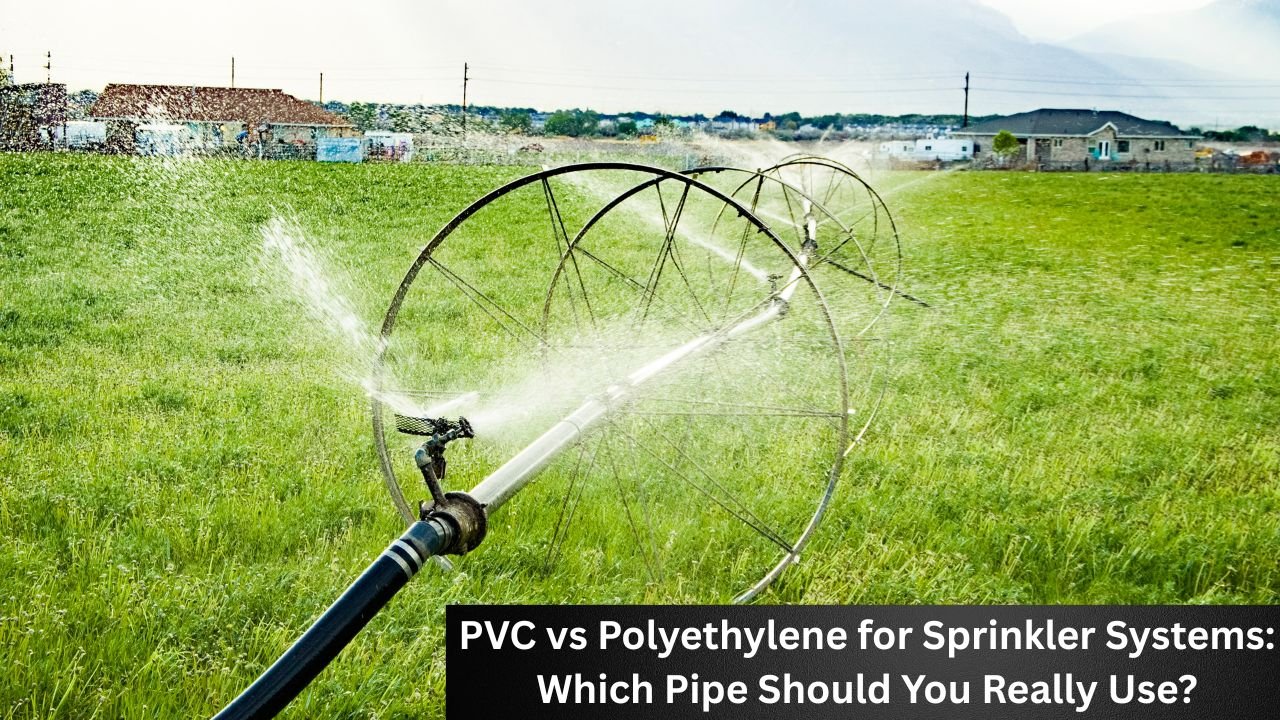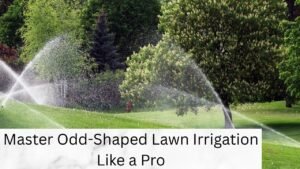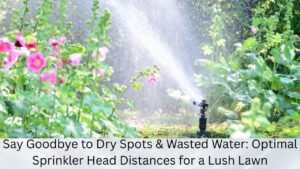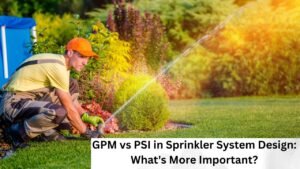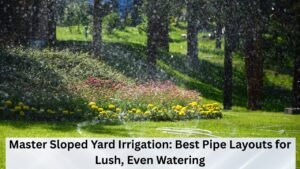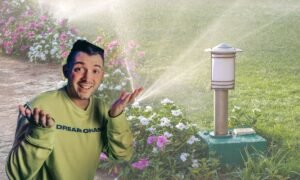Introduction: PVC vs Polyethylene Sprinkler Pipe
When choosing drip irrigation materials, the cost difference between polyethylene tubing and PVC pipe adds up fast. Each material has trade-offs in durability, flexibility, and price. The youtube video below: Saving Money: Polyethylene Tubing Versus PVC Pipe Drip by DiTuroProductions (YouTube, June 20, 2025) breaks down those factors in detail so you can decide where to save without cutting corners.
Sprinkler system pipe choice isn’t just about what’s cheaper at the hardware store—it’s about matching the right material to your yard’s layout, climate, and your own comfort level with installation. When comparing a PVC vs polyethylene sprinkler pipe, both have strengths, but they serve very different needs.
Let’s break down which pipe fits your project best, with zero fluff and all the good stuff.
No One-Size-Fits-All: Why the Choice Isn’t Obvious
If you’re hoping there’s one clear winner here—sorry, it’s not that simple. You’ve got:
- Flexibility vs. Rigidity
- Glued vs. Clamped Connections
- Cold Weather Tolerance
- Installation Complexity
- System Pressure Requirements
Material matters, but pipe size is just as critical. Learn how size impacts flow in our Sprinkler Pipe Size and Flow Chart.”
Each factor pulls you in a different direction. But knowing how these differences affect your setup will save time, stress, and costly repairs down the line.
Understanding PVC: Rigid But Reliable
Most homeowners choose Schedule 40 PVC for lateral lines. To learn how that choice affects flow and pressure, see our full pipe sizing and flow chart guide.
Thinking about system pressure and PSI loss? Get up to speed on GPM vs PSI and how pipes affect both.
What is PVC?
I shed light on the world of PVC—what PVC actually is, and why it’s so versatile. The youtube video below: What Is PVC Plastic? | Polyvinyl Chloride Explained from Plascon Plastics (YouTube, published about 4.2 years ago) gives a clear, concise breakdown of polyvinyl chloride—how it’s used in everything from construction to flexible products, and why it’s labeled as the number 3 plastic.
PVC (Polyvinyl Chloride) is a rigid white plastic pipe. It’s super common in residential and commercial irrigation systems, especially in areas with mild climates.
Pipe Markings Explained
Look for “Schedule 40” or “Schedule 80” printed on the pipe:
| Schedule | Wall Thickness | Pressure Rating | Common Use |
| 40 | Standard | ~200 PSI | Lateral lines |
| 80 | Thicker | ~300 PSI | Rare in lawn irrigation, but used in high-pressure zones or where code requires it |
PVC’s rigidity allows for clean, straight runs, but it means zero flex. You cut it to length and glue everything using solvent cement and primer. The fittings come in slip or threaded types.
Connecting to Sprinkler Heads
Most systems use rigid risers or swing joints with PVC. Swing joints are flexible arms that help protect your sprinkler heads from damage and allow easy adjustment.
Installation Skill & Challenges
- Precise cutting is critical
- Solvent welding involves fumes
- Proper curing time needed before pressure testing
- Hard to maneuver around tight corners
Cold Weather and Water Hammer
If winter is a concern and you’re eyeing PVC, check your options first. You might save big on long-term maintenance by understanding how long these pipes really last.
Repairing PVC
Repairs can be a pain. You’ll need to:
- Cut out the damaged section
- Use a coupler
- Re-glue everything precisely
- Wait for it to cure
Not exactly a 5-minute fix.
Polyethylene Pipe: Bend It, Flex It, Love It
Poly’s flexibility shines when you’re working around tree roots, slopes, or winding trenches. If that’s your layout, poly might save time and elbow grease. Just keep in mind that while it bends, it also fails more often—so bookmark this sprinkler pipe leak repair guide just in case.
What is Poly Pipe?
Polyethylene is black flexible tubing—sold in coils—that’s widely used for lateral lines in home sprinkler systems. It comes in Low-Density (LDPE) and High-Density (HDPE) varieties.
- LDPE: More flexible, easier to bend around obstacles, good for lateral zones
- HDPE: Stronger, thicker walls, often used for high-pressure main lines or commercial installs
Pipe Markings and Pressure Ratings
Check the pipe for “SDR” markings (Standard Dimension Ratio):
| Type | SDR | Approx. PSI Rating | Use Case |
| LDPE | 13.5 or higher | ~60–100 PSI | Lateral lines, drip systems |
| HDPE | 11 or lower | 160+ PSI | Main lines, high pressure zones |
Connecting to Sprinkler Heads
Poly connects to funny pipe or flexible swing joints using barbed insert fittings. These heads handle ground movement better and are less likely to break if stepped on.
Fittings: Clamp or Compress
You’ve got two main options:
- Barbed Fittings + Stainless Clamps: Easy and cheap, great for DIYers
- Compression Fittings: More reliable, pricier, and require no tools
Installation Challenges
- Avoid kinks while unrolling or curving the pipe
- Clamp tightening must be just right—too tight = leaks, too loose = slips
- Coiled pipe can be springy and tricky to control
Cold Weather and Water Hammer
Poly excels in cold climates. It flexes, so it resists damage from frost heave or minor freezing. But don’t skip winterization entirely. Water left inside can still cause issues.
Bonus: Poly slightly dampens water hammer effects, reducing stress on fittings over time.
Repairs Made Easy
Just snip out the bad section and insert a new piece with barbed or compression fittings. No cure time. No waiting.
Friction Loss & Flow Characteristics
This is a subtle point, but still worth knowing.
PVC has a slightly smoother inner wall than poly. That means marginally less friction loss over long runs at high flow. However, in most home systems, pipe diameter matters more than this small difference.
UV & Chemical Resistance
Both pipe types should be buried—but if you’re budgeting for materials, remember that UV protection coatings cost more. View the sprinkler installation cost breakdown to compare material and labor side-by-side
Future Modifications & Expansion
Poly wins this round. Need to move a line? Add a new zone? Poly’s easy to cut and re-fit. PVC’s more involved—you’ll cut, clean, glue, and wait. Not fun mid-summer.
Testing Before You Bury: Don’t Skip This!
No matter which pipe you pick, pressure test the system before backfilling.
- PVC Fail: You might need to dig up and redo glued joints
- Poly Fail: Easier—cut the pipe, install a new fitting, re-clamp
Skipping this step is asking for future leaks.
Real-Life Use Cases: What’s Best for Your Yard?
I highlight creative ways to transform outdoor spaces without overspending. The video below: What You Can Do With Your Yard by 9NEWS (YouTube, August 15, 2024) showcases smart ideas for landscaping, water use, and curb appeal.
PVC is better if:
- Your layout is mostly straight lines
- You live in a mild climate
- You want strong, clean installs with solvent-welded joints
Poly works better if:
- You’re in a colder climate
- Your yard has lots of curves or elevation changes
- You want a DIY-friendly install or easy future modifications
- Your soil moves a lot (expansive clay, frost heave, etc.)
- You’re installing pipe under driveways or rocky ground (Poly’s impact resistance is better)
Expanding an Existing System?
Match the material that’s already installed unless there’s a solid reason to switch.
Key Questions to Ask When Choosing Your Sprinkler Pipe:
- What’s your local winter temperature?
- Is your soil rocky, sandy, or clay-heavy?
- Are you digging straight trenches or curving around obstacles?
- Do you prefer gluing or clamping?
- What pressure and flow do you need?
- Are you planning future expansions?
- What’s more important—initial cost or long-term repair ease?
Final Take: PVC or Poly?
Whether you’re patching an old poly system or debating a PVC upgrade, you need to compare more than just flexibility. Cost, durability, repair frequency, and long-term reliability matter too. Run the numbers with our repair-or-replace guide before making your final call.
